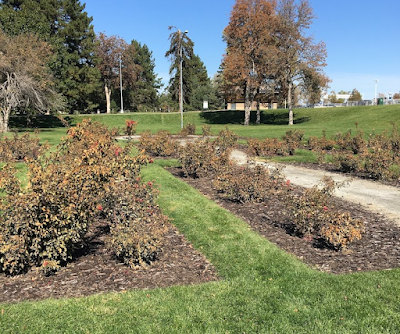Posted by: John Murgel, Horticulture and Natural Resources Agent, Douglas County
The color I most associate with fall? Blue.
Don't get me wrong--I love pumpkins (and the spices that go with them), have nothing against sweaters, and can even tolerate the early sunsets and cold, dark mornings.
1. Clean, clean,
clean. Remove any frost-damaged plants
or overgrown, dead, or diseased annuals.
Disease and pest organisms often overwinter in plant debris. Removing them from your garden will also make
space for…
 |
| Sure the mulch is tidy. Wouldn't this look nice in springtime with some daffodils? |
2. Fall-planted perennials!
The warm ground and cooler air temperatures (for a less stressful
establishment) make for good conditions for many perennials to establish. Some garden centers even have plants on
sale! Remember that your new plants will
need watering through any prolonged dry periods in the winter—just keep an eye
one them and give them a drink when the top inch or two of their planting-mix
is dry and the temperature is above freezing.
And if you’re already outside digging, don’t forget…
 |
| Galanthus (Snowdrop) flowers regularly bloom in January and February along the Front Range. |
3. Bulbs!
Fall-planted bulbs can be some of the most rewarding spring plants in
Colorado. Most bulbs are well adapted to
Colorado’s “continental” climate and moisture regime. If deer are a problem for you, stick with
daffodils (Narcissus varieties) or hyacinths (Hyacinthus varieties). For a bright spot in late winter (sometimes
as early as the end of January), don’t forget the snowdrops (Galanthus)
and snow buttercups (Eranthis hyemale)!
Check your bulbs for mold, soft spots, and signs of insects before
planting—avoid purchasing bulbs you can’t inspect beforehand! Plant bulbs about twice as deep as the bulb is
tall— the top of a 3” tall bulb would be 6” down, for example. For an instant springtime container display,
consider planting some of your bulbs in pots—4” plastic pots saved from other
plants are my favorites. Wash the pots
and plant the bulbs in potting mix.
Water them well this fall, and tuck them in a shady spot of the yard,
either under some leaves or under some frost-cloth (add a layer of hardware
cloth if squirrels or voles are a problem in your area). As the bulbs sprout in the spring, simply
sink the plastic pots into your decorative containers. If a late spring frost threatens, you can
even bring the “liner” pots indoors to protect them!
4. Finally, consider growing some perennials from seed. Native and drought-adapted plants can be tough to find at nurseries in the spring, but seeds are often available. Consider trying to sow them directly in place in the landscape, or into small pots. For pot-sown seeds, treat them as you would bulbs grown the same way--water them after planting, tuck them someplace shady for the winter, and keep them from drying out by covering with leaves or frost cloth. I like to pile snow from the patio onto my seed trays! Check starting when temperatures are regularly above freezing, and meet your new plant-friends just in time for spring!
 |
| Focus less on the "dandelion" and more on the "pink"! These Taraxacum pseudoroseum plants are a great example of a plant you won't find for sale at the garden center, but seeds are readily available! |


No comments:
Post a Comment